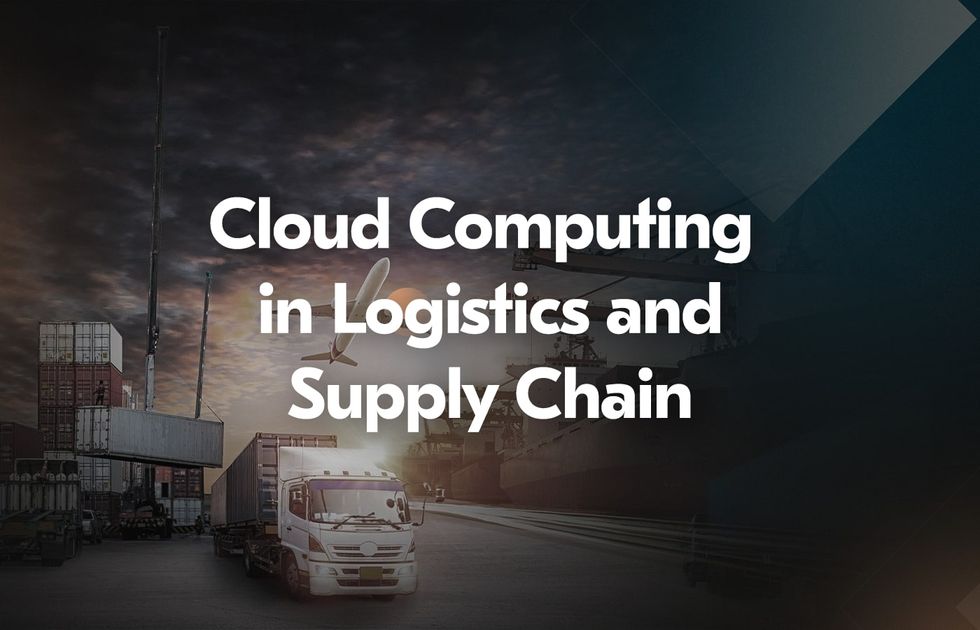The Role of Cloud Technology in Enhancing Supply Chain Efficiency

The world moves fast, and efficient management of supply chains is key for business. In recent years, cloud technology has become an asset in aiding companies to cut costs and increase flexibility for supply chain operations. And what exactly is cloud technology? In simpler terms, it helps businesses to save and run data across the internet instead of a local server or computer.
The paradigm shift to the cloud brings multiple advantages. All companies need to do is expand, and they just have to pay for using resources. The real-time data can help them in tracking their inventories and the shipments for their customers. This also makes it a lot easier to work with other parts of the supply chain, improving coordination and streamlines.
Cloud technology allows multiple IT resources, and the dynamic nature of cloud computing services offers scalability to businesses. This flexibility comes in handy during peak seasons or product launches.
Use Case: A retail company that experiences a significant increase in online orders can add capacity to the servers during the holiday season and reduce it after this period, thereby not paying for resources they do not consume.
By utilising cloud solutions, businesses can remain agile and adapt quickly as market conditions change without rearchitecting IT infrastructure.
Use Case: A manufacturer can rapidly re-plan its production schedules and inventory levels in response to up-to-the-minute market information, ultimately reducing lead times and improving its ability to respond to customer needs.
The cloud platforms offer real-time access to supply chain data lending insights into levels of inventory, statuses of shipment and schedules of production.
Use Case: A logistics firm could enable its buyers to track the location and status of goods in transit through a cloud-based tracking system, helping ensure that deliveries are made on time and reducing spoilage.
With the help of AI and machine learning, cloud solutions can leverage historical data to predict demand, uncover trends and optimize inventory levels.
Use Case: An e-commerce company can forecast what commodities will be sold in higher quantities particular time of year and adjust its stock accordingly to manage both stockouts and surplus.
It is a cost savings measure as it greatly reduces the need for on premise infrastructure, maintenance costs etc. Using only resources when they need it, companies are cost-effective.
Use Case: A nascent manufacturing startup can tap into the integrated resources through a breed of cloud service providers, hence harnessing latest IT capabilities without having to shell out significant upfront amounts towards traditional servers and data centers.
The benefit of cloud technology is that it can automate monotonous back and forth, thus reducing costs associated with manual labour.
Use Case: Warehouses can be linked to cloud-based inventory management systems that automatically monitor stock-taking, when it is time for products to be reordered and with a system of excel on steroids avoid the need for manual intervention thus increasing accuracy.
The cloud platforms make it easy to share real-time information and work together with other stakeholders of the supply chain like suppliers, manufacturers, and retailers.
Use Case: Global manufacturing Enterprises can use cloud-based collaboration platform to maximize coordination with suppliers and partners from different time zones where everybody has the latest information and delays are minimized.
Cloud solutions help by offering a single truth source and synchronization between activities inside the supply chain that lead to better coordination across all parts of the business.
Use Case: A food and beverage company can synchronize farm-to-table supply chain operations to deliver fresh, on-time product, while maintaining compliance.
Analyze historical patterns for better demand forecasting and inventory management by predicting future trends with the help of AI & ML algorithms.
Use Case: A fashion retailer applying AI on customer data to predict the stock of his in next season using past sales data and reducing leftover clothes.
Automatic AI platform automation which allows to automatically and efficiently deal with repetitive tasks such as order processing, invoicing & customer service.
Use Case:An electronics manufacturer employs AI-driven automation to monitor its procurement pipeline, automatically issuing orders for components whenever inventory dips below a certain level — allowing it to keep up production without lag times.
Through real-time traffic and weather data, together with expected delivery schedules, machine learning algorithms can find the optimal routes for drivers which makes them not only reduce transportation costs but also improve on delivery times.
Use Case: A company that offers logistics solutions, uses machine learning to optimize routes when routing its fleet of trucks, reducing fuel consumption and improving delivery times.
Sensors and GPS trackers attached to goods can provide real-time insights into the location and condition of items, giving users better visibility throughout their supply chain.
Use Case: A pharmaceutical company deploying IoT Sensors at many important Covid-19 vaccine transportation containers, to monitor that critical shipmant avoiding an out of temperature range fall good conditions and its efficacy.
Sensors and automated solutions make up IoT-enabled smart warehouses, which track inventory levels, stock placement, and order fulfillment processes.
Use Case: International e-commerce company reaches mass-scale with global IoT deployments automating warehouse inventory tracking and picking processes, getting orders out the door faster than ever.
Machinery and equipment can be monitored by IoT-devices, allowing predictive maintenance to anticipate failures before they happen, which prevents downtime and repair costs.
Use Case: A manufacturing plant installs IoT sensors to production machinery in order to observe its performance and anticipate when maintenance is needed, so as not only avoid the unexpected breakdowns but also peak up scaled productivity.
The ledger created through blockchain is tamper-proof and transparent that makes it easy to trace products within the supply chain.
Use Case: A blockchain solution which helps a food supplier to track the origin of their products in order to provide consumers with trusted information on the journey of that product and compliance with food safety regulations.
Smart contracts can be designed on blockchain to automate and secure contractual arrangements with supply chain collaborators (reducing the need of intermediaries) and execution (faster transactions).
Use Case: a logistics company that introduces smart contracts so carriers get automatically paid on deliver confirmation, making this process more smooth and decrease the number of disagreements between both sides.
Therefore, having a blockchain is useful in that it allows you to check the provenance of particular items along a supply chain.
Use Case: A high-end manufacturer authenticates their goods on blockchain, which enables customers to verify where the purchase originates and that it is indeed a legitimate one; helps in preventing counterfeiting.
Low-code platforms are ideal for rapidly developing and deploying supply chain applications with little or no coding to help businesses change more quickly than changes in their business needs.
Use Case: Small manufacturer builds custom inventory management system to work on top of ERP with low-code platform in use case
These platforms bring together different supply chains processes and systems into one, enabling a full view and ensuring coordination.
Use Case: A logistics company Monster Logistics uses a low-code application to integrate their transportation management system (TMS) with the Warehouse Management System, End Equation improved visibility and coordination throughout their entire supply chain.
By using low-code platforms, developers and the unsophisticated individual can develop or modify various applications to effect more agile and responsible supply chain management.
Use Case: A retail chain allows store managers to build personalized reporting tools on a low-code platform, making it easier for them to monitor live sales & inventory data so they can decide based on data.
CloudComputing offers a rapidly expandable IT infrastructure on demand to make it easier for organizations to scale up their supply chain operations without having to invest heavily in the first instance.
Use Case: An e-commerce company, which is continuously expanding its reach globally, wants to be able to increase the scale of orders processing [through cloud services] during times with high shopping activity seamlessly and efficiently.
Cloud platforms facilitate the integration of data from various sources, providing a centralized repository that can be accessed from anywhere, at any time.
Use Case: A global manufacturing enterprise uses cloud-based supply chain management software to aggregate data from factories, warehouses and suppliers into one system for real-time visibility and more accurate decisions.
They provide versatile disaster recovery capabilities for business continuity if the system crashes or is interrupted.
Use Case: A company offers logistics services, choosing to back up its operational data in the cloud; thus guaranteeing its full availability in case of a failure affecting one of the data centers.
One of the most promising applications for quantum computing is supply chain, which pose some of the more unyielding logistical challenges and critical processes on human timeframes. Big Data and other computational languages_seen as suitable for large was being processed easily.
Use Case: A logistics company can plan out optimal delivery routes factoring in real-time traffic updates, weather conditions as well the courier's window to deliver goods and assets leading to cost-effective deliveries(strtolower operational costs) With quantum powered machines they could perform these tasks much faster efficient than available supercomputers every deployed concentrating on outputs delivered.
The bots in question are used to automate repetitive work, and thereby free up the staff to do tasks that robots simply cannot replicate. Supply Chain Ordobotswire Robotic Help!
Use Case: Warehouses could deploy robots to pick and pack items, automating the process of order fulfillment while also reducing errors.
Tailored supply chain processes: AI hyper-personalization maps and adjusts the entire supply chain to service each customer separately. This method increases customer satisfaction and operational efficiency.
Use Case: Retailers to intelligently schedule deliveries based on customer preference, achieving quicker and accurate deliveries.
This real-time integration technology that brings reams of AR and VR training, transforming the training and operational processes into a lively environment.
Use Case: Warehouse workers use AR glasses for picking guidance in real-time, which improves the accuracy and speed of a pick while VR is used to simulate more complex environments for training Warehouse Use Case
These are sustainability technologies, designed to help herd supply chains reduce their carbon footprints. This will apply to electric vehicles, green packaging — as well as energy-efficient warehouses.
Use Case: electric trucks are used for service companies to lessen co two exhausts, a storehouse instalment of solar panels minimise its intake of power.
The potential uses of the collected plant data are broad Companies remain vigilant to and in some cases, target their Scope 3 emissions as well — that is, all indirect emissions generated by a company across its entire value chain.
Use Case: A manufacturing company may use cloud-based platforms to obtain emissions data from suppliers, thus helping them better monitor and report Scope 3 emissions. This data is vital in setting and meeting aggressive reduction milestones that can be linked to sustainability goals.
The integration of green solutions in supply chain operations like low energy-consuming machinery and eco-friendly materials helps to diminish the environmental impact as a whole.
Use Case: A logistics firm could implement LED warehouse lighting solutions and bolt-on solar panels to reduce the amount of energy used in their buildings while actively participating in green initiatives.
Cloud technology is transforming supply chains by making them more efficient, flexible, and sustainable. Emerging technologies like quantum computing, robotic process automation, hyper-personalization, and augmented reality are helping businesses solve complex problems, automate tasks, and enhance operations.

For modern telecom enterprises, delivering exceptional QoS is no longer optional—it’s a brand differentiator and a strategic lever for growth. Static provisioning models won’t cut it in a world of hyper-dynamic data usage.